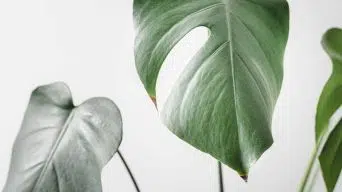The Monstera, also known as the Swiss Cheese Plant, is a popular houseplant choice due to its large, glossy leaves, ease of care, and its ability to add an exotic touch to any room.
However, even the most experienced plant parent may find themselves with a drooping Monstera.
If your Monstera leaves are drooping, there could be several reasons why.
This article will discuss seven possible causes of drooping Monstera leaves and what you can do to fix the problem.
How to Fix Drooping Monstera Leaves
Monstera care can be relatively straightforward. However, one issue you may encounter is drooping leaves.
This can happen for various reasons and is usually nothing to worry about.
Here are 7 main reasons why your Monstera leaves may be drooping:
1. Insufficient Water
One of the most common problems with Monstera plants is that their leaves droop from lack of water.
This usually happens when the plant is not getting enough water, causing the leaves to lose moisture and become limp.
Monsteras are native to tropical rainforests, so they are accustomed to getting a lot of water.
When they are not getting enough, their leaves will start to droop to conserve water.
Identifying Dehydration
There are a few ways to tell if your Monstera needs water.
The first is to check the soil. If it is dry to the touch, then your plant needs water.
You can also determine if a Monstera is not receiving enough water by examining its leaves.
If they are wilting, yellowing, or drooping, this is usually a sign that the plant needs more water.
Treating a Dehydrated Plant
If you suspect your Monstera is not receiving adequate water, it is best to water it thoroughly.
Ensure to saturate the potting soil during watering and allow any excess water to drain away.
Monstera plants typically require watering about once a week, but this frequency can vary based on the plant’s size, potting mix, and room temperature.
It’s crucial not to overwater your plant, so ensure the soil is dry before the next watering.
To prevent overwatering, establish a watering schedule that allows you to check the soil’s dryness before providing more water. This practice will help you maintain a consistent watering routine, promoting the health and vitality of your plant.
After watering your plant, you should notice an improvement in the leaves within a few days.
2. Excessive Watering
While insufficient water can cause Monstera leaves to droop, too much water can also be problematic.
Overwatering can be caused by watering too often, using a potting mix, or a pot that does not drain well.
If a plant’s roots sit in water for too long, they will start to rot, and the plant will begin to droop.
When the roots start to rot, they will not be able to absorb water and nutrients properly, which will cause the plant to suffer.
Spotting Overwatering
There are a few signs that your Monstera plant is overwatered.
The initial indication of a problem is the presence of wilting or yellowing leaves. When Monstera leaves begin to turn yellow and drop, it indicates that the plant isn’t receiving sufficient oxygen.
Another sign of overwatering is root rot. If the roots are black or mushy, this is a sign that they are rotting.
You may also see mold or mildew on the potting soil mix or the plant leaves.
Addressing Overwatering
If you think your Monstera is getting too much water, the best thing to do is to stop watering it for a while.
Allow the soil to dry out completely before watering again.
Repotting the plant in fresh potting mix and a pot with drainage holes will help to ensure that the plant is getting the proper amount of drainage to allow excess water to escape, preventing the plant from becoming waterlogged.
If the roots are damaged, you may need to cut them back into healthy tissue.
3. Inadequate Lighting
Monstera drooping leaves is often a sign that the plant is not getting enough light.
The leaves will start to grow smaller, and the stem will stretch out as it tries to reach for more light.
Monstera plants prefer bright indirect light but can also tolerate some direct sun.
However, too much direct sunlight will scorch the leaves.
Recognizing the Need for More Light
One way to tell if your Monstera needs more light is to check the leaves for signs of stress.
The leaves of the plant should be a vibrant green color, indicating that it is receiving enough light for photosynthesis and healthy growth; however, if the leaves are pale or have yellow spots, this is a sign that the plant is not getting enough light and the green hue of the leaves is fading.
Another way to tell if your plant needs more light is to check the growth rate.
If the plant is growing slowly or producing small leaves, this is also a sign that it is not getting enough light.
Remedies for Insufficient Light
If your Monstera needs more light, the best solution is to move it to a brighter location.
Make sure to do this gradually so the plant can adjust to the new light level.
A west- or east-facing window is a good option for Monsteras. This will provide the plant with bright, indirect light.
If you cannot provide your plant with enough light, you can also try using grow lights.
Grow lights are a great way to give your plant the extra light it needs to thrive.
4. Low Humidity Levels
Monstera plants come from the tropical rainforests of Central and South America, so they prefer high humidity.
If the air in your home is too dry, it can cause the leaves of your plant to droop.
A dry environment will cause the leaves to lose water faster than they can take it in, which will cause the plant to suffer.
Detecting Low Humidity
There are a few signs that your droopy Monstera plant needs more humidity.
One is the brown tips on the leaves. This is caused by the leaves losing too much water.
Another sign is wilting leaves. If the Monstera leaves are curling or drooping, this is a sign that the plant is not getting enough moisture.
Low humidity can also cause the leaves to grow small and stunted.
Alleviating Low Humidity Stress
If your Monstera plant needs more humidity, you can do a few things.
One is to mist the plant regularly. This will help to increase the moisture in the air around the plant.
You can also try placing the plant on a pebble tray. This tray filled with water and pebbles will help increase the humidity around the plant.
Another option is to use a humidifier. This will help to raise the overall humidity in your home.
You can also group your Monstera with other houseplants. This will create a mini-greenhouse effect and increase the humidity around the plants.
5. Temperature Stress
One of the most common problems with Monsteras is temperature stress.
This can manifest in various ways, but one of the most noticeable is drooping leaves.
The foliage of a thriving Monstera plant typically exhibits a sturdy and erect posture. However, under conditions of stress, the leaves may display a tendency to droop and lose their upright position.
High and low temperatures can cause temperature stress, but sudden changes most commonly cause it.
Identifying Temperature-Induced Stress
One way to tell if your Monstera is stressed by temperature is to check the leaves.
If the leaves are wilting or drooping, this is a sign that the plant is not happy with the temperature.
Another way to tell if your plant is stressed by temperature is to check the growth rate.
If the plant is growing slowly or produces small leaves, this is also a sign that it is not happy with the temperature.
Alleviating Temperature-Induced Stress
If your Monstera plant is stressed by temperature, the best thing you can do is try to stabilize the temperature.
This means avoiding sudden changes in temperature and keeping the plant in an area between 65 and 80 degrees Fahrenheit.
You can also try using a humidifier to help keep the air around the plant moist.
Keep your Monstera away from drafts and heat sources, which can also cause stress.
It will be much happier if you can provide your plant with a consistent temperature.
6. Pests and Diseases
Pests and diseases are other common problems that can cause Monstera leaves to droop.
One of the most common pests that affect Monstera plants is scale. This tiny insect sucks the sap out of the plant, causing it to become weak and stressed.
Mealybugs are another type of pest that can infest Monstera plants. These are small, white insects that feed on the plant’s sap.
Diseases can also cause Monstera droopy leaves.
One common disease is bacterial leaf spot. This bacteria attacks the leaves of the plant, causing them to turn black and eventually drop off.
Fungal diseases can also cause the leaves of your Monstera to droop. One of the most common is powdery mildew. This is a white, powdery fungus that thrives in dry conditions.
Detecting Pests or Diseases
One way to tell if your droopy Monstera has pests or diseases is to check the leaves.
If you see any small insects or white powder on the leaves, this is a sign that something is wrong.
Another way to tell if your Monstera has pests or diseases is to check the leaves for signs of damage.
If the Monstera leaves are turning black, yellow, or brown, this is a sign that they are being attacked by something.
Remedies for Pests or Diseases
If your Monstera has pests or diseases, the best thing you can do is to treat it with a natural pesticide or fungicide.
Neem oil is an excellent option for treating pests and is safe for humans and animals.
For diseases, you can try using a copper fungicide. This will help to kill the fungus and prevent it from spreading.
You can also try to remove the pests by hand.
If you see any small insects on the leaves, you can remove them with a cotton swab dipped in rubbing alcohol.
7. Transplant Shock
Transplant shock is another common problem that can cause Monstera leaves to droop.
This is when the plant is moved from one container to another or from one location to another.
The plant will undergo a period of adjustment as it tries to acclimate to its new environment.
During this time, the leaves may droop, or the plant may stop growing.
Recognizing Transplantation Shock
One way to tell if your Monstera is in shock is to check the leaves.
If the leaves are wilting or drooping, this is a sign that the plant is not happy with its new environment.
The leaves will also turn yellow or brown if the plant is shocked.
In general, it will not look as vibrant as it did when you first got it.
Addressing Transplantation Shock
If your Monstera is in shock, the best thing you can do is to give it time.
The plant will eventually acclimate to its new environment, and the leaves will return to normal.
In the meantime, you can try to help the plant by giving it a little extra water.
You can also try misting the leaves with water to help keep them from drying.
Preventing Monstera Leaf Drooping
To prevent your Monstera leaves from drooping, you must provide the plant with the proper care.
Here are 7 tips on how to do so:
- Make sure that your plant is getting enough light. Monsteras need bright indirect sunlight to thrive. If your plant is not getting enough light, the leaves will start to droop.
- Water your plant regularly and evenly. They need to be kept moist but not wet. If the plant is too dry, the leaves will droop.
- Make sure that the soil is well-draining. They do not like to sit in wet, soggy soil. The roots will start to rot if the plant sits in water for too long.
- Do not fertilize too often. They do not need a lot of fertilizer. Fertilizing once a month during the growing season is sufficient.
- Prune your plant regularly. Pruning promotes the development of fresh growth and safeguards against the Monstera plant becoming overly elongated.
- Repot your plant every two to three years. Monsteras need room to grow. Repotting helps refresh the soil and gives the plant more space to grow.
- Monitor the temperature and humidity levels. They prefer warm, humid conditions. Keep the plant away from drafts and cold temperatures.
By following these tips, you can prevent your Monstera leaves from drooping.
Give your plant the proper care and attention it needs, and it will thrive.
Final Thoughts
Monstera plants are beautiful tropical additions to any home. These indoor plants are relatively easy to care for, but they do require some special attention.
Ensure that your houseplant receives adequate light, water, and fertilizer. Regular pruning and repotting every two to three years are essential.
Monitor the temperature and humidity levels to ensure your plant remains comfortable. With the right care, your Monstera will thrive, and its leaves will stay perky.
Thank you for reading!







